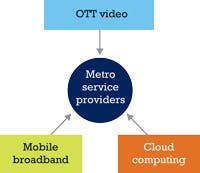Packet-optical transport for metro services delivery
By ROBERT KEYS
Five elements to ponder when evaluating packet-optical transport systems for the metro.
As the “onramp” for wholesale, consumer, and business traffic, the metro network is rapidly becoming the most critical link in the value-added services delivery chain (see Figure 1). This trend is unfolding in an environment where bandwidth demands are increasing exponentially but budgets to add capacity remain constrained. Meanwhile, subscriber churn has reached an all-time high and competition has continued to escalate. New strategies must be developed to transform metro services delivery – or else content and service providers risk commoditization.
Packet-optical transport platforms can enable network service providers to capitalize on new revenue opportunities while overcoming the metro network’s challenges. We’ll present the points network planners should consider to determine the optimal approach for transforming legacy metro infrastructures into new efficient networks that can profitably handle large volumes of over-the-top video, cloud computing, and mobile broadband traffic – and capture the new revenue-generating opportunities that accompany this transition.
The metro problem/opportunity
Unprecedented levels of traffic growth have pushed many existing metro networks to the brink (see Figure 2). For example:
- Worldwide subscriber spending for online video soared to $3.5 billion in 2011 (Strategy Analytics).
- In the U.S. alone, 181 million people watched online video content in January 2012 – or 58% of the U.S. population (comScore).
- Netflix consumes as much as 30% of the Internet’s bandwidth during peak hours (Sandvine).
- One billion consumers will own smartphones by 2016, with mobile spending reaching $1.3 trillion by then (Forrester Research).
- There will be 1.8 billion broadband subscribers worldwide by 2014 (Infonetics Research).
- The global cloud services market is anticipated to triple in size over the next four years with a compound growth rate of 29.4% to reach revenues of $66 billion in 2016 (Ovum).
FIGURE 1. The “onramp” for wholesale, consumer, and business traffic, the metro network is ideal for enabling high-value services.
Yet the formidable challenges this growth presents come with a multibillion-dollar opportunity for new services and revenues. The necessary network transformation starts with a reevaluation of existing infrastructures. The resulting plan should enable providers to migrate their networks and monetize assets and market services, yet control capital and operational expenditures.
Traditional transport networks feature discrete optical and packet layers with distinct networking equipment, management interfaces, and provisioning systems. Fixed optical layers are expensive to manage and maintain over time and represent inherent risks. They require user-intensive procedures and significant preplanning. These legacy optical networks cannot ensure efficient support of increasing bandwidth demands. Additionally, legacy optical networks are often difficult to provision, which can make it hard for a network operator to move quickly to add services to win important new business.
FIGURE 2. Growth in over-the-top (OTT)
video, cloud computing, and mobile broadband
are driving bandwidth demands in the metro.
Many metro-network operators also have had limited visibility into or control of the upper layers of the network stack and are thus unable to implement service-level agreements (SLAs) based on application or content type. Notably, this deficiency also precludes their ability to influence IP video, rich media, and other bandwidth-intensive, delay-sensitive traffic flows. Today, metro services networks have to be able to support the breadth of services based on:
- Applications, industry verticals, and specific customer requirements.
- The ability to move large amounts of traffic into, across, and out of the network.
- The creation of services, assurances, and delivery.
- Highly leveraged, optimized assets for a better return on investment.
Accommodating growth and accelerating services delivery requires that service providers identify and proactively address issues of scalability, capacity expansion, ease of use, management, and costs. Additionally, providers must seek strategies to move up the value chain to gain new revenues while cost-effectively managing the enormous growth of content (see Figure 3).
Winning metro strategy
Recognizing that rapid bandwidth growth is a reality – and that metro services delivery is changing dramatically – metro providers must alleviate capacity issues and network inefficiencies to improve the customer quality of experience (QoE) and enable the delivery of rich new high-value services. There are five key considerations for a winning strategy.
Reduce complexity and improve scalability by converging Ethernet and optical service layers into a converged packet-optical infrastructure. Consider starting the network transformation by converging service layers to create a simpler, more dynamically scalable network with fewer layers, less equipment, and unified operations, administration, and management. Converged optical and Ethernet layers will consolidate equipment and cabling; save energy, cooling, and facility costs; and reduce expenses. This strategy also will create a solid foundation to optimize bandwidth and accelerate the delivery of rich high-value services.
Streamline provisioning and troubleshooting functions to achieve end-to-end visibility into services and customers. Converged network layers eliminate the need for separate organizations to handle packet and optical traffic, a structure that’s costly and inefficient. By breaking down the “wall” between the Ethernet and optical layers, network operators can easily adjust transport capabilities and realize end-to-end visibility of service demands and customer requirements. With a real view into what’s happening in the network, operators can deploy new services quickly, scale the network almost automatically, and make better decisions to alleviate bandwidth strain while freeing resources.
FIGURE 3. Service providers require a services delivery framework
that addresses scale, end-to-end service visibility, and application
awareness.
Analyze, monitor, and control services based on content or application type to reduce strain on bandwidth and make more effective use of resources. End-to-end network visibility supports the development of new revenue-generating services that include SLAs. The ability to keep track of traffic ensures delivery of required levels of bandwidth and low latency for consumers and businesses and creates a clear competitive advantage – and the opportunity to charge SLA premiums. Network-view analytics can also help use resources more effectively. For example, analytics can help determine if certain types of traffic, such as Netflix, should be stored in a cache device closer to the subscriber to reduce bandwidth strain and improve QoE.
Create new value-added or tiered services with assured QoE based on the ability to intelligently prioritize traffic flows. With the ability to monitor and control traffic, metro-network operators can create new service bundles for subscribers, such as unlimited high-speed social networking or YouTube access. Service bundles can help reduce customer churn and act as a differentiator to secure new subscribers. Traffic can be prioritized based on customer demands rather than treating all traffic with the same level of importance, enabling more efficient use of bandwidth resources without having to add new equipment.
Use integrated platforms to move up the value chain, participate in new revenue streams, and avoid marginalization. Service providers control the QoE of the subscriber. Consumers expect high-quality, predictable experiences, especially when viewing purchased content. Dissatisfaction drives subscriber churn. An intelligent, converged infrastructure with analytics enables service providers to create alternatives to conventional content delivery networks. Such infrastructure also supports two-sided business models in which operators capture incremental revenues from upstream content providers and downstream content consumers. Metro providers thus can become part of the digital media distribution chain, building relationships with content providers and aggregators by offering SLAs and detailed subscriber information in exchange for subscription commissions or advertising revenue sharing. Also, metro-network operators have the opportunity to introduce premium service bundles (as mentioned earlier) to consumers to boost revenues, margins, and subscriber base expansion.
Taking an active role
These are exciting – and challenging – times for metro-network operators. Digital media is pervasive and growing, especially with the proliferation of mobile smart devices. A data point: Apple has sold more than 55 million iPads since its launch in 2010, with an additional 55 million expected to be sold in 2012. With a new iPad model just being unveiled, those numbers may well increase. Metro service providers can avoid the risks of commoditization by transforming their networks and becoming active participants in the digital media ecosystem. By doing so, they will increase margins, grow revenues, and be more competitive.
ROBERT KEYS is chief optical architect at BTI Systems.




